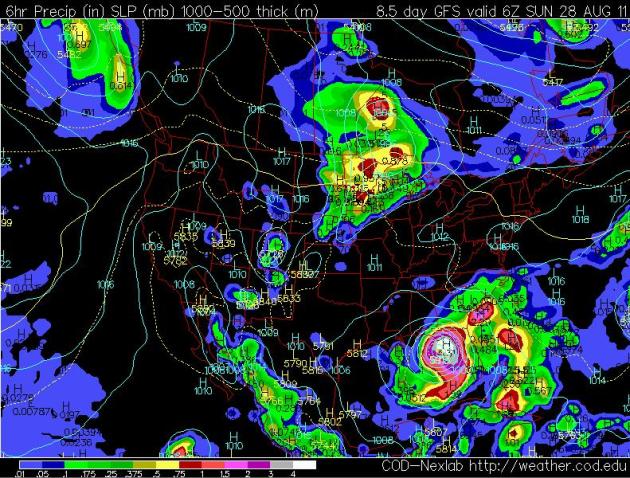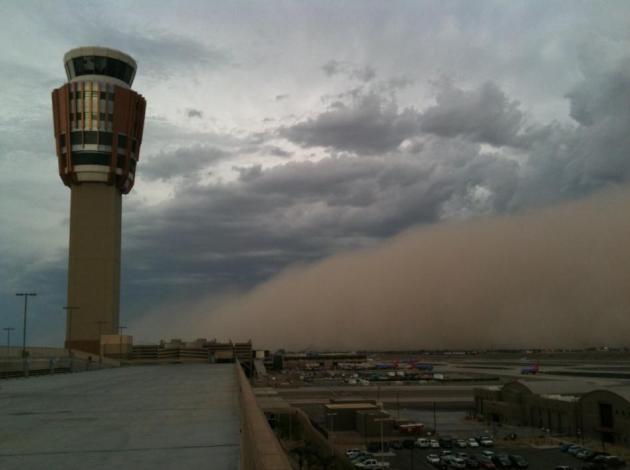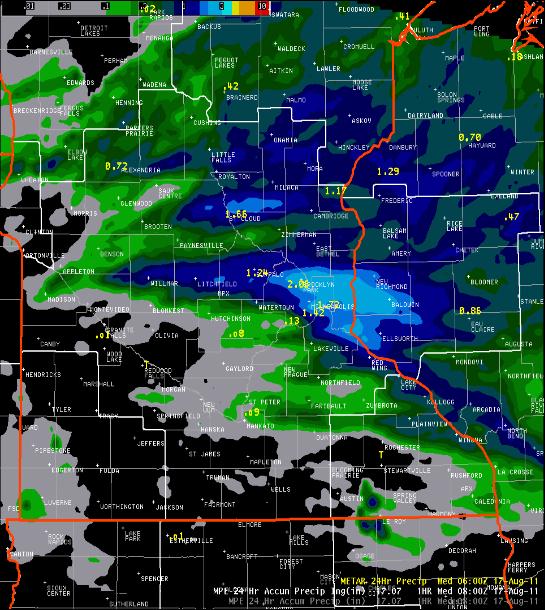 Tropical Storm Harvey
Tropical Storm Harvey. I am enjoying the new crop of names: Gert, Harvey, next up: Irene! Tropical Storm Harvey's 50 mph winds brushed the northern coastline of Honduras late Friday, expected to weaken rapidly over Central America in the coming days, still capable of some 10-15" rains. Map courtesy of NHC and Ham Weather.
 Hurricane Irene?
Hurricane Irene? It's still (wildly) speculative, and the track will most assuredly change (several times) between now and the end of next week. But the GFS
model continues to bring a tropical storm across the Carribean, possibly brushing south Florida before (possibly) entering the Gulf of Mexico late next week. The map above shows a hurricane centered just south of Mobile, Alabama next Sunday morning at 1 am. The accuracy of an 8 day forecast? Not good, but the models have been fairly consistent bringing "something" into the Caribbean late next week. Stay tuned...

 Another Haboob!
Another Haboob! Thanks to Elizabeth Garcia, who sent these photos of the latest haboob (massive sandstorm) to invade the Phoenix metro area late Thursday. Elizabeth sent these photos into our
WeatherNation FB page - we appreciate it!
(Minnesota's) Weather Has Been A Disaster. The last 18+ months have featured the most severe weather in Minnesota since 1953. Bill McAuliffe at the
Star Tribune has the details: "
Floods and tornadoes have led to more federally declared disasters in Minnesota in each of the past two years than in any other year since at least 1953. Spring floods, urban tornadoes in May, and outbreaks of tornadoes and straight-line windstorms in early July resulted in three disaster declarations this year. That matches the total from 2010, which featured spring flooding, a record single-day tornado outbreak and devastating autumn flash flooding. Last year also brought a federal emergency declaration. Minnesota's experience parallels a national trend. Last year, there were a record 81 disaster declarations nationwide. The number of such declarations has risen steadily over time, from just seven in both 1958 and 1959. Texas has led the way with 85 declarations since 1953; Minnesota is 14th with 48 since 1957, according to the Federal Emergency Management Agency. This year there has been at least $46.3 million in damage to public infrastructure in Minnesota from the three federal weather disasters. That makes it already the fifth-costliest year since 2000, with one-third of the year ahead. The year is also already the third in a row with more than $45 million of federally declared disaster damage. The dollar figures are only a fraction of the total damages, since they don't include most private losses, said Doug Neville, Minnesota Department of Public Safety spokesman."
Two Doses Of Heavy Rain Earlier This Week. Mark Seeley takes a look at another June-like week across Minnesota in his weekly
WeatherTalk blog: "Between 5:00 pm and 8:00 pm on Tuesday, August 16th many parts of central Minnesota reported very heavy thunderstorms. Some observers recorded over two inches including: 2.09 inches in Little Canada, 2.48 inches in Stillwater, 2.30 inches at Lake Elmo, 2.67 inches at Fridley, 3.08 inches at Maple Grove, 2.33 inches in Maplewood, 3.31 inches in Vadnais Heights, 2.18 inches in Plymouth, and 2.56 inches in Pine Springs. Some intersections and basements in those communities were flooded. The National Weather Service issued a flash flood warning for portions of Anoka, Hennepin, Chisago, Wright, , and Meeker Counties among others. The University of Minnesota St Paul Campus received 1.89 inches over that same time period. An analysis of this storm is available at the National Weather Service Chanhassen
web site."
Belgium Music Festival Canceled After Stage Collapse Kills Five. This is starting to get a little freaky - last month a stage collapsed from high winds in Oklahoma, then the Cheap Trick stage collapse in Ottawa, Canada, last Saturday's tragic stage collapse at the Indiana State Fair, and now a new collapse in Belgium. What is going on? A symptom of more severe local storms, shoddy construction, or a little of both?
CNN has the latest: "
One of Europe's largest outdoor music festivals was canceled Friday after a stage collapsed during a violent storm in Belgium, killing five people and injuring 50 others, organizers said. Belgian authorities confirmed Friday that the death toll has gone up. "A fifth person has died," Andy Payne, spokesman for the nation's crisis center, told CNN. He said he did not know the circumstances surrounding the death. The storm struck Thursday just hours after Pukkelpop kicked off. The scheduled three-day event was in Hasselt, east of Brussels. Strong winds ripped up trees and smashed them into one of the festival's eight stages, Belga national press agency reported. Belgian authorities are investigating the stage collapse, which struck those who had gathered to watch the Smith Westerns perform, Belga reported."
 The American Identity According To Social Media. PCmag.com
The American Identity According To Social Media. PCmag.com has a fascinating article about our obsession with social media, British royalty, and celebrities of every size, shape and color: "
For example, I had no idea that 65 percent of all social media content relating to the British royal wedding derived from the United States, even though it it apparently shattered records for online traffic. (That benefited Yahoo, by the way.) And though we've touched upon Farmville and its creator, Zynga, from time to time, the amount of hours gamers put into it is amazing: more than 63 million active users spend an average of 15 minutes per day pretending to run a farm. Over the course of a year, that's 5,475 minutes, or the equivalent of two weeks at a full-time job by a single user. Yikes. And Americans are nostalgic: the average Facebook user has 229 friends. According to Hasai, less than 10 percent are college friends, more than 20 percent are friends from high school. Oh, and as you head to your vacations, keep in mind that the Jersey Shore is likely to be filled with tanned tweens tapping away at cell phones. That's because New Jersey is second in friend requests, the study found, second only behind North Dakota. Maybe that's because nobody wants to go outside during the winter?"


Weather Ramblings
"When all is said and done, the weather and love are the two elements about which one can never be sure," wrote Alice Hoffman. Amen to that. “Conversation about the weather is the last refuge of the unimaginative,” according to Irish poet Oscar Wilde. I disagree.
Weather is one of the few things that unites all of us (along with muttering about the Twins, Vikes & Gophers). Weather is the pond in which we live - it impacts our schedules, our commutes, recreation plans, even the food on our dinner table. Americans have a God-given right to brag (and complain) about the weather. What a summer: record humidity levels & especially severe storms; every other day some nearby town seems to get whacked by a tropical downpour. Second wettest summer on record for Chicago while Texas bakes (83 days above 100 at Wichita Falls). And next week we may have plenty to talk about - with a possible tropical storm or hurricane brushing south Florida - possibly drifting into the Gulf of Mexico. Stay tuned for updates.
Climate Stories...
A Climate Change "Bummer Outer" Comes To Washington D.C. The
New York Times has the (vaguely ominous) story: "
Johnsburg, N.Y. -- If you think the record droughts, famines, storms and floods that many scientists say are being caused by climate change are bad now, Bill McKibben is setting out to assure you that these effects will only get worse, more expensive and harder to avoid. A gaunt, soft-spoken environmental writer who has spent 21 years and almost a dozen books trying to convince the United States to deal with greenhouse gas emissions, McKibben, 50, sometimes describes himself to adoring college audiences as a professional "bummer outer." He explained his approach to ClimateWire during a hike up a mountain near this tiny Adirondack town where he spends his summers: "I think my job as a writer and journalist is to tell the truth, and not to write it so that you make people feel better than we should about this. I think the course we are on is not working." (photo credit:
billmckibben.com).
NASA Map Reveals Climate Change Clues.
Sky News has the story: "
It is hoped that the map will be extremely useful for tracking future sea-level increases as a result of climate change. The map was created using integrated radar observations from a consortium of international satellites. Eric Rignot of Nasa's Jet Propulsion Laboratory in California has described how this new technology is a "game changer for glaciology". "We are seeing amazing flows from the heart of the continent that had never been described before," he added Rignot worked with Jeremie Mouginot and Bernd Scheuchl using billions of data points captured by satellites to weed out the cloud cover, solar glare and land features masking the glaciers."
Climate Change May Incite Aliens To Destroy Humanity, NASA Warns. Yes, this is one of the stranger headlines I've stumbled upon in recent weeks. In the spirit of full disclosure here's an excerpt of an article from
smartplanet.com: "
NASA scientists propose that we curb our greenhouse gas emissions in order to prevent aliens from blowing us up. The researchers argue that if extraterrestrials detect the alarming rate at which our atmosphere is changing due to the incredible amounts of carbon dioxide we spew into it every year, they may decide to eliminate us in order to prevent the damage to Earth from worsening. I wish I could call this a modest proposal, but it seems to be an earnest one. I’m all for cutting greenhouse gas emissions to keep Earth’s climate suitable for human habitation, but even I find their ideas far-fetched. In Would Contact with Extraterrestrials Benefit or Harm Humanity? A Scenario Analysis (pdf), scientists from NASA’s Planetary Science Division and Pennsylvania State University explore three potential types of contact with aliens: beneficial, neutral and harmful. The 33-page paper depicts some scenarios of beneficial contact: One is that the aliens advance our knowledge and help us solve global afflictions like hunger, poverty and disease. Another is that interplanetary travelers help us fend off an attack from other space invaders."
 Critters Moving Away From Global Warming Faster.
Critters Moving Away From Global Warming Faster. The story from
Yahoo News and the AP: "
WASHINGTON (AP) — Animals across the world are fleeing global warming by heading north much faster than they were less than a decade ago, a new study says. About 2,000 species examined are moving away from the equator at an average rate of more than 15 feet per day, about a mile per year, according to new research published Thursday in the journal Science which analyzed previous studies. Species are also moving up mountains to escape the heat, but more slowly, averaging about 4 feet a year. The species — mostly from the Northern Hemisphere and including plants — moved in fits and starts, but over several decades it averages to about 8 inches an hour away from the equator. "The speed is an important issue," said study main author Chris Thomas of the University of York. "It is faster than we thought." Included in the analysis was a 2003 study that found species moving north at a rate of just more than a third of a mile per year and up at a rate of 2 feet a year. Camille Parmesan of the University of Texas, who conducted that study, said the new research makes sense because her data ended around the late 1990s and the 2000s were far hotter."
Photo credit: The image (above) provided by Stanford University biologist Scott Loarie, shows an American Pika in Aug. 2008 in Desolation Wilderness in El Dorado County, Calif., near Lake Tahoe. Animals across the world are fleeing global warming by moving north and up twice as fast as they were less a decade ago, a new study says. About 2000 species examined are moving away from the equator at an average rate of more than 15 feet per day, about a mile per year, according to a giant study of new and old research in the journal Science published Thursday. Species are also moving up mountains to escape the heat, but more slowly, averaging about four feet a year. (AP Photo/Scott Loarie)













